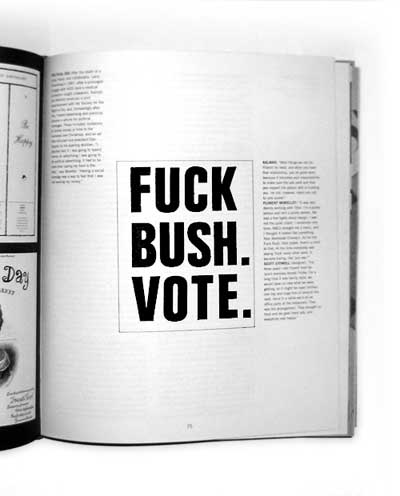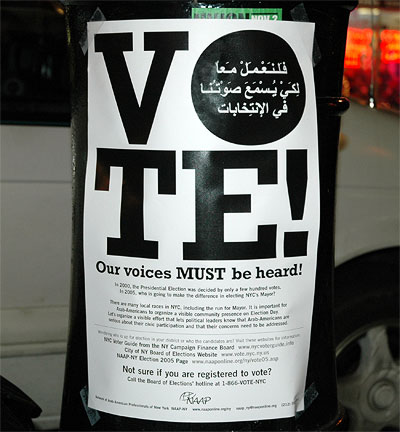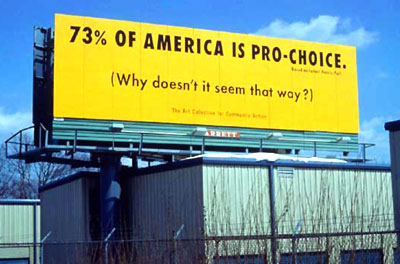November 2005
Vote No on Arnold

Passing through San Francisco, I spotted these near 16th street and Valencia. The Arnold poster says nothing about the substance of the initiatives — it doesn’t need to. For locals, there’s no explanation necesary.
A Brief History of Peru
From Inca to conquest to liberation, in a mural.
Free Yingying!
The 2008 Beijing Olympics Committee today announced their five Official Mascots:
“Like the Five Olympic Rings from which they draw their color and inspiration, the Five Friendlies will serve as the Official Mascots of Beijing 2008 Olympic Games, carrying a message of friendship and peace — and blessings from China — to children all over the world.
Designed to express the playful qualities of five little children who form an intimate circle of friends, the Five Friendlies also embody the natural characteristics of four of China’s most popular animals — the Fish, the Panda, the Tibetan Antelope, the Swallow — and the Olympic Flame.”
That’s the same Tibetan Antelope now teetering on the edge of extinction — endangered by infrastructure development and poaching. (Its wool is some of the finest in the world.)
The character is intended to project an image of happy diversity:
“His head ornament incorporates several decorative styles from the Qinghai-Tibet and Sinkiang cultures and the ethnic design traditions of Western China.”
Students for a Free Tibet, however, notes another agenda:
“The Chinese authorities’ plan to use the Tibetan antelope as propaganda purporting the unity of the nationalities in China in order to distract from the reality that China has illegally occupied Tibet for more than 50 years can be seen clearly in the statements made at the mascot unveiling ceremonies. According to Liu Qi, head of the Olympics organizing committee, the mascots ‘reflect the cultural diversity of China as a multi-ethnic country... and the enthusiasm and aspirations of our people.’
The Tibetan antelope is not a Chinese symbol and is being used to legitimize China’s occupation of Tibet.”
SFT is encouraging letters to Mr. Liu Qi. For more, see the SFT and Human Rights Watch campaigns on the 2008 Olympics in China.
Blue Plate Special
Kimberly from Australia emails:
“[I am writing] to see if you have a copy of Tibor Kalman’s ‘Fuck Bush. Vote’ poster. Reading your post today about the bilingual poster for the NYC elections made me remember Tibor’s and would love to see it.”
Here you go. A shot of page 75 in Tibor Kalman: Perverse Optimist:

Before his famous “political advertising” for Benetton, Kalman and his company M&Co created such at the behest of Florent Morellet, owner of the eponymous bistro in the meatpacking district.
The text on the page above reads:
“After the death of a close friend, and collaborator Larry Rosenberg, in 1987, after a prolonged struggle with AIDS (and a medical profession caught unawares), Kalman and Morellet produced a joint advertisement with the Society for the Right to Die, and, increasingly after this, Florent advertising and publicity became a vehicle for political messages. These included invitations to donate money or time to the homeless over Christmas, and an ad that ridiculed vice-president Dan Quayle for his spelling abilities.
‘I decided that if I was going to spend money on advertising I was going to do political advertising; it had to be more than saying my food is the best,’ says Morellet. ‘Having a social message was a way to feel that I was not wasting my money.’
Kalman: ‘Most things we did for Florent he liked, and when you have that relationship, you do great work, because it becomes your responsibility to make sure the ads work and that you respect the person who is trusting you. He did, however, reject our call to vote poster.’Florent Morellet: ‘It was very stormy working with Tibor. I’m a pushy person and he’s a pushy person. We had a few fights about design. I was not the quiet client.... As for the Fuck Bush, Vote poster, there’s a limit to that. At the time everybody was saying ‘fuck’ every other word. It became boring, like ‘you see.’’
Scott Stowell (designer): ‘For three years I ate Florent food for lunch everyday except Friday. For a long time it was family style; we would have no idea what we were getting, so it might be roast chicken one day and huge tins of borscht the next. Once in a while we’d do an office party at the restaurant. That was the arrangement. They brought us food and we gave them ads, and everybody was happy.’”
Florent has a history of community engagement. In 2003, with preservationist Jo Hamilton, he helped earn landmark recognition for the Gansevoort Historic District.
The context of the Florent ads, arising from rage and personal loss, and even the barter arrangement, make the feel a lot less crass and gratuitously provocative than Kalman’s later work for Benetton.
---
See previous posts Half Empty on Tibor and Commodify Your Dissent on merchant politics.
Get Out the Vote

It’s election day today in NYC. I spotted this in Bay Ridge Brooklyn this weekend.
The bilingual poster does not endorse a particular candidate or ballot initiative, simply the vote itself. It’s not trying to sell anything but political power.
The poster reads:
“There are many local races in NYC, including the run for Mayor. It is important for Arab-Americans to organize a visible community presence on Election Day. Let’s organize a visible effort that lets political leaders know that Arab-Americans are serious about their civic participation and that their concerns need to be addressed.”
Political power in New York City can often be drawn among community lines. This often becomes a game of numbers, and graphics in community spaces play a small but important part.
Class Action

Class Action bills itself as “The Art Collective for Community Action.”
From classactioncollective.org:
“Class Action creates visual messages to advocate social change. Our goal is to influence the way public issues are understood, and motivate audiences to participate in civic dialogue. We work as a collective, authoring, producing and publishing our ideas & initiating projects to illuminate attitudes and conditions overlooked in mainstream media.
Our work originates outside of the studio, with a perception of something taking place in the world. Often beginning with the newspaper or newscast, we define an issue, research it, and craft a message that can lead to some real-world action or change. We work in the spirit of the phrase, ‘pro bono publico’, meaning ‘for the public good’. We endeavor not only to communicate our own position but also to inspire others to become active.
As graphic designers, we have the power to lend authority to messages that would normally be seen on the fringes of society. Through design, we gain access to the official channels of communication & the organizations, institutions, leaders and media that have great sway over social values and priorities. What we place in these channels is an attempt to challenge, influence and provoke.”
Class Action started as just that, in 1992 at the Yale School of Art. Several designers have been associated with the collective since then.
Check their list of public projects. Among them:
- T-shirts and an exhibition on AIDS awareness
- a talk show media kit and T-shirt on the “abortion pill” RU-486
- a poster challenging the gender bias of AIGA
- a billboard on domestic violence
- a public service announcement on teen pregnancy
- and posters on gun control
My personal favorite is this surreptitious pamphlet challenging the AIGA’s commitment to public engagement:
“Washington DC, 2002: The American Institute of Graphic Arts National Conference ‘Voice!’ promises a radically new focus on serious public issues. Yet the AIGA design competitions criteria continue to emphasize form over content. The satirical pamphlet, written and designed to conform to the identity of the conference materials, challenges the AIGA to recognize the purpose and social value of design.”
From the pamphlet:
“New Categories for 365: AIGA annual design competitions
The new competitions will reward design that best works toward:
- Establishing justice
- Insuring domestic tranquility
- Providing for the common defense
- Promoting the general welfare
- Securing the blessings of liberty
- Forming a more perfect union
By the end of voice we trust you will agree that these criteria and categories are what really matter.”
The common defense bit gets a bit murky in this perpetual “war on terror”, but I think the piece hits the right place at the right time. Within the context of the membership conference, it starts to move beyond public awareness into mobilization. Nice to see the Left seizing ‘American-ness,’ too.
I’ve argued here before about how the AIGA and competitions could be a force for change, so it’s nice to see AIGA members taking them to task, too — and nearly a month before I started this blog!
Here’s looking forward to more work — and to keeping the pressure on!
Exeunt

How bitter to see ads for RENT plastered on the Barnes & Noble at Astor Place. You know, the one across from the new glass tower of luxury condos atop the Chase Bank?
The summer I moved to NYC marked the third anniversary of the Tompkins Square Riot, captured obliquely in the play. Freshmen were warned not venture east of Avenue A after dark. Now you can’t get a table there without a reservation.
Gentrification, squatters, art, AIDS, drugs, poverty, homelessness, riots, gender bending, love and death in the East Village — now a major Hollywood motion picture. Coming soon to the East Village.
Guernica, USA
John T. Unger writes in about his campaign:
“I thought you might be interested in helping spread the word about a call for participation. I’m looking for artists/activists who can help get billboard sized reproductions of Picasso’s Guernica installed in as many US locations as possible.”

From his blog:
“Ideally, the work would stand without any text or headlines or additional commentary: if the painting is all that’s seen, it forces the viewer to make an interpretation instead of being told what to think. Being told what to think is exactly what got Americans in trouble in the first place, no?
In terms of how the project is carried out, I don’t really think it matters whether billboards are rented, plastered over in dark of night (see: BLF, the Billboard Liberation Front) or created just for this purpose. Obviously not everyone has the budget to actually rent billboard space, though it seems like this might be an option for funded activist groups. Now that most billboards are made to hold printed tarps rather than pasted up sheets of paper, it would certainly be easier and faster for guerrilla Guernicas to be painted on canvas and installed at whim. For those who do take the guerrilla approach, it might help to read this basic primer on how to appropriate billboards. Also check out the Wooster Collective for ideas and techniques.
I don’t think it matters whether the images are photos, stencils, handpainted, collaged or what. If the project really took off, part of the excitement would be seeing the results of many different people interpreting a well know work in their own way. I will happily publish any photos sent in by participants of the project.”
The project is, in part, a test of his idea of “open-sourcing art projects” to involve as many participants as possible.


